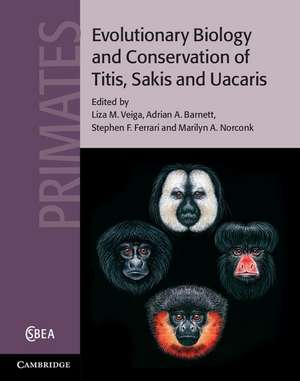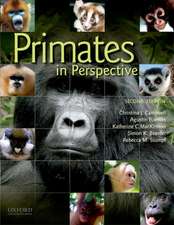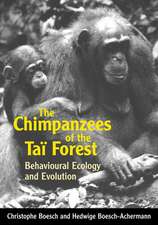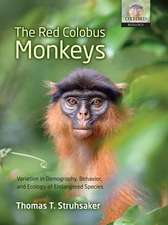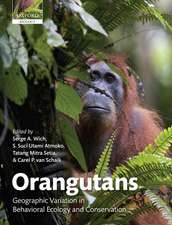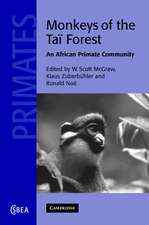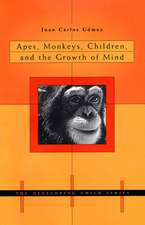Evolutionary Biology and Conservation of Titis, Sakis and Uacaris: Cambridge Studies in Biological and Evolutionary Anthropology, cartea 65
Editat de Liza M. Veiga, Adrian A. Barnett, Stephen F. Ferrari, Marilyn A. Norconken Limba Engleză Hardback – 10 apr 2013
Din seria Cambridge Studies in Biological and Evolutionary Anthropology
-
 Preț: 479.80 lei
Preț: 479.80 lei -
 Preț: 390.84 lei
Preț: 390.84 lei - 14%
 Preț: 750.86 lei
Preț: 750.86 lei - 11%
 Preț: 700.59 lei
Preț: 700.59 lei - 14%
 Preț: 722.61 lei
Preț: 722.61 lei - 9%
 Preț: 846.79 lei
Preț: 846.79 lei - 11%
 Preț: 460.98 lei
Preț: 460.98 lei - 11%
 Preț: 566.50 lei
Preț: 566.50 lei -
 Preț: 367.91 lei
Preț: 367.91 lei - 11%
 Preț: 693.77 lei
Preț: 693.77 lei -
 Preț: 356.37 lei
Preț: 356.37 lei - 11%
 Preț: 633.61 lei
Preț: 633.61 lei - 11%
 Preț: 619.90 lei
Preț: 619.90 lei -
 Preț: 396.29 lei
Preț: 396.29 lei -
 Preț: 279.00 lei
Preț: 279.00 lei -
 Preț: 304.74 lei
Preț: 304.74 lei -
 Preț: 371.32 lei
Preț: 371.32 lei -
 Preț: 376.06 lei
Preț: 376.06 lei -
 Preț: 332.66 lei
Preț: 332.66 lei -
 Preț: 421.01 lei
Preț: 421.01 lei -
 Preț: 303.60 lei
Preț: 303.60 lei -
 Preț: 309.27 lei
Preț: 309.27 lei -
 Preț: 376.62 lei
Preț: 376.62 lei - 11%
 Preț: 424.92 lei
Preț: 424.92 lei -
 Preț: 308.50 lei
Preț: 308.50 lei -
 Preț: 317.11 lei
Preț: 317.11 lei -
 Preț: 453.33 lei
Preț: 453.33 lei -
 Preț: 322.41 lei
Preț: 322.41 lei -
 Preț: 433.83 lei
Preț: 433.83 lei -
 Preț: 435.78 lei
Preț: 435.78 lei -
 Preț: 471.93 lei
Preț: 471.93 lei - 11%
 Preț: 474.71 lei
Preț: 474.71 lei -
 Preț: 428.90 lei
Preț: 428.90 lei - 14%
 Preț: 934.70 lei
Preț: 934.70 lei
Preț: 920.49 lei
Preț vechi: 1070.34 lei
-14% Nou
Puncte Express: 1381
Preț estimativ în valută:
176.14€ • 184.37$ • 146.60£
176.14€ • 184.37$ • 146.60£
Carte tipărită la comandă
Livrare economică 31 martie-14 aprilie
Preluare comenzi: 021 569.72.76
Specificații
ISBN-13: 9780521881586
ISBN-10: 0521881587
Pagini: 420
Ilustrații: 88 b/w illus. 25 colour illus.
Dimensiuni: 223 x 282 x 24 mm
Greutate: 1.45 kg
Ediția:New.
Editura: Cambridge University Press
Colecția Cambridge University Press
Seria Cambridge Studies in Biological and Evolutionary Anthropology
Locul publicării:Cambridge, United Kingdom
ISBN-10: 0521881587
Pagini: 420
Ilustrații: 88 b/w illus. 25 colour illus.
Dimensiuni: 223 x 282 x 24 mm
Greutate: 1.45 kg
Ediția:New.
Editura: Cambridge University Press
Colecția Cambridge University Press
Seria Cambridge Studies in Biological and Evolutionary Anthropology
Locul publicării:Cambridge, United Kingdom
Cuprins
Contributor list; Part I. Fossil History, Zoogeography and Taxonomy of the Pitheciids: 1. Pitheciidae and other Platyrrhine seed predators; 2. The misbegotten: long lineages, long branches and the interrelationships of Aotus, Callicebus and the Saki-Uacaris; 3. A molecular phylogeography of the Uacaris (Cacajao); 4. Taxonomy and geographic distribution of the Pitheciidae; 5. Zoogeography, genetic variation and conservation of the Callicebus personatus group; Part II. Comparative Pitheciid Ecology: 6. Morphological and ecological adaptations to seed predation - a primate-wide perspective; 7. Pitheciines: use of time and space; 8. Functional morphology and positional behaviour in the Pitheciini; 9. Male cooperation in Pitheciines: the reproductive costs and benefits to individuals of forming large multimale/multifemale groups; 10. Evolutionary ecology of the pitheciinae: evidence for energetic equivalence or phylogenetically structured environmental variation?; 11. Competition between Pitheciines and large Ara macaws, two specialist seed-eaters; 12. On the distribution of Pitheciine monkeys and Lecythidaceae trees in Amazonia; Part III. Genus Reviews and Case Studies: 13. Why we know so little: the challenges of fieldwork on the Pitheciids; 14. Ecology and behaviour of Uacaris (genus Cacajao); 15. Annual variation in breeding success and changes in population density of Cacajao calvus ucayalii in the Lago Preto Conservation Concession, Peru; 16. Cacajao ouakary in Brazil and Colombia: patterns, puzzles and predictions; 17. Ecology and behaviour of titi monkeys (genus Callicebus); 18. Costs of foraging in the Southern Bahian Masked Titi Monkey (Callicebus melanochir); 19. Insectivory and prey foraging techniques in Callicebus - a case study of Callicebus cupreus and a comparison to other pitheciids; 20. Seed eating by Callicebus lugens at Caparú Biological Station, on the lower Apaporis River, Colombian Amazonia; 21. Callicebus in Manu National Park: territory, resources, scent marking and vocalizations; 23. Feeding ecology of Uta Hick's Bearded Saki (Chiropotes utahickae) on a man-made island in southeastern Brazilian Amazonia: seasonal and longitudinal variation; 24. The behavioural ecology of Northern Bearded Sakis (Chiropotes satanas chiropotes) living in forest fragments of Central Brazilian Amazonia; 25. Ecology and behaviour of saki monkeys (genus Pithecia); 26. Finding the balance: optimizing predator avoidance and food encounters through individual positioning in Pithecia pithecia during travel; 27. Testing models of social behaviour with regard to inter- and intra-troop interactions in free-ranging white-faced sakis; 28. Comparative socioecology of sympatric, free-ranging white-faced and bearded saki monkeys in Suriname: preliminary data; 29. Pair-mate relationships and parenting in Equatorial Saki Monkeys (Pithecia aequatorialis) and Red Titi Monkeys (Callicebus discolor) of Ecuador; 30. Vocal communication in Cacajao, Chiropotes and Pithecia: current knowledge and future directions; Part IV. Conservation of the Pitheciids: 31. The Guyana Shield: Venezuela and the Guyanas; 32. Pitheciid conservation in Ecuador, Colombia, Peru, Bolivia, and Paraguay; 33. Brazil; 34. Pitheciines in captivity: challenges and opportunities, past, present and future; 35. The challenge of living in fragments; 36. Communities and Uacaris: conservation initiatives in Brazil and Peru; Appendix - country factsheets; Index.
Recenzii
'This comprehensive volume, with contributions from 101 authors, reviews previous and ongoing research and outlines strategies for future investigations … Recommended. Upper-division undergraduates through professionals in primatology and biological anthropology.' E. J. Sargis, Choice
Descriere
The first detailed collation of the evolution, ecology and conservation of some of South America's least-known, and most endangered, primates.
